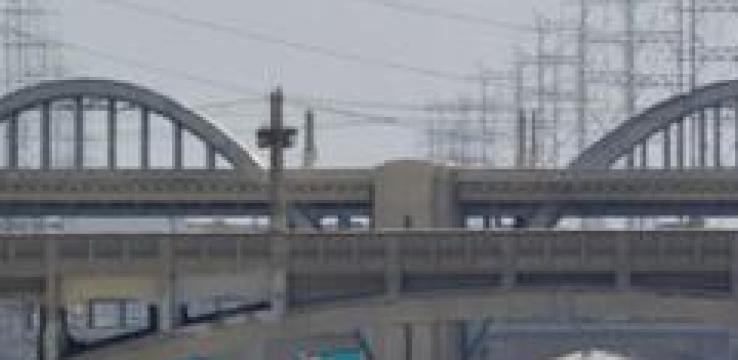Channelized and diked for nearly its entire 51-mile length, the Los Angeles River has appeared in numerous Hollywood action scenes — like the hotrod race in Grease — as a wide, dry concrete ditch, not resembling a river at all (other than in the most postmodern, dystopic sense). But a long-term plan now under way aims to give it a different future, restoring the river as the centerpiece of a cross-town greenway that offers new open space, recreation and natural habitat in the dozens of communities along the river’s course.
Historically, the L.A. River meandered around the floodplain that was pre-urbanized Los Angeles. In flood, the river would dramatically alter course, meeting the ocean anywhere between Santa Monica and Long Beach, 30 miles to the south. As development encroached in the early 20th century, the river had less room to move. Meanwhile, its floods became more dramatic as more of its watershed was paved, shunting stormwater straight into the river’s banks. In 1913, the completion of the Los Angeles Aqueduct from the Owens Valley provided a bigger, more reliable water supply for the city, and the river lost some of its importance. After one particularly catastrophic flood in 1938, the Army Corps of Engineers commenced the process of entombing the river in concrete on three sides. The project was completed in 1959. Some sections of the river were left in a more natural, soft-bottom condition; today, these places host wildlife (including more than 200 species of birds) and provide scenic views on nearly 30 miles of riverside bike and walking paths. But in many places, just a thin ribbon of water flows through an extrawide channel, surrounded by fences and trash. Every time it rains, the river roils as storm drains contribute to its exponential rise and unnaturally fast flush to the sea.
But momentum is building to give the river a different future. Environmental advocates, community activists, the city and the federal government all recognize that restoring the waterway would bring community benefits, ecological benefits and economic development. In 2007, the City of Los Angeles, with federal and community partners, published the Los Angeles River Revitalization Master Plan. The plan is a 25- year blueprint to transform the river by restoring its ecosystem and water quality, creating public access, celebrating the river’s cultural heritage, greening the surrounding neighborhoods and connecting them to the river through urban design, public art and a greenway with bike and pedestrian paths. The plan includes 20 “opportunity areas” for revitalization efforts, with five major priority areas for early implementation. Ideas for the makeover include new public parks, wetlands, promenades, ponds with overlooks and naturalizing the concrete channel. Economic benefits from the opportunity areas, once they are built out, are estimated at several billion dollars, including thousands of new jobs and long-term tax revenue increases. Along with adopting the plan, the city created a new governance framework for revitalization efforts. This included establishing three new organizations: a joint powers authority for river reconstruction and maintenance, a nonprofit corporation to direct financing into real estate and economic development and a foundation to raise private funds.
In the five years since the plan’s adoption, much has been accomplished. More than $50 million has been acquired from federal and local sources for land acquisition and demonstration projects. Sections of bike path and pocket parks have been completed. Riverwalks and greenways are being designed. The city planning commission adopted a River Improvement Overlay District, which applies sustainable design guidelines to private development and public right-of-way projects within roughly half a mile on either side of the river. The city has also adopted green infrastructure policies to better manage stormwater. Finally, with the Environmental Protection Agency’s declaration of the river as a navigable waterway, giving it federal clean water protections, the Army Corps has permitted public access to the river in a few places. Last summer, the city launched a pilot program to allow guided public boating on a 3-mile segment through the San Fernando Valley — the first time public recreation on the water has ever been allowed.
Through this process, Los Angeles is joining many other large cities in realizing the benefits of urban watershed revitalization. Other examples of river restoration projects paired with community and economic development efforts include the Anacostia River in Washington, D.C., the Charles River in Boston, the San Antonio River Walk and, perhaps most famously, South Korea’s Cheonggyecheon, which had been completely covered by a highway prior to being restored as a river and greenway through downtown Seoul in 2005. Closer to home, the Guadalupe River Park offers downtown San Jose a 3-mile stretch of trails, parks and plazas while providing habitat for birds and wildlife as well as critical flood control — an analogue, albeit smaller, to the vision for the L.A. River. All of these projects would be worth San Francisco’s consideration, as it is poised to invest several billion dollars to improve the seismic safety and sustainability of its wastewater system but has not yet taken seriously the idea of restoring urban creeks as part of that project.
The L.A. River enabled the City of Los Angeles to establish itself and grow into the incredibly rich and diverse place that it is. It is heartening to see that the city is beginning to return the favor.

